21 Creative Mud Kitchen Ideas for Kids to Spark Imagination
Get ready to spark your child’s imagination with 21 fun and creative mud kitchen ideas! These engaging projects will encourage outdoor play, messy exploration, and endless hours of pretend cooking fun. From easy DIY setups to creative additions, you’ll find inspiration to transform any backyard into a playful culinary haven.
Natural Elements in Mud Kitchen Design
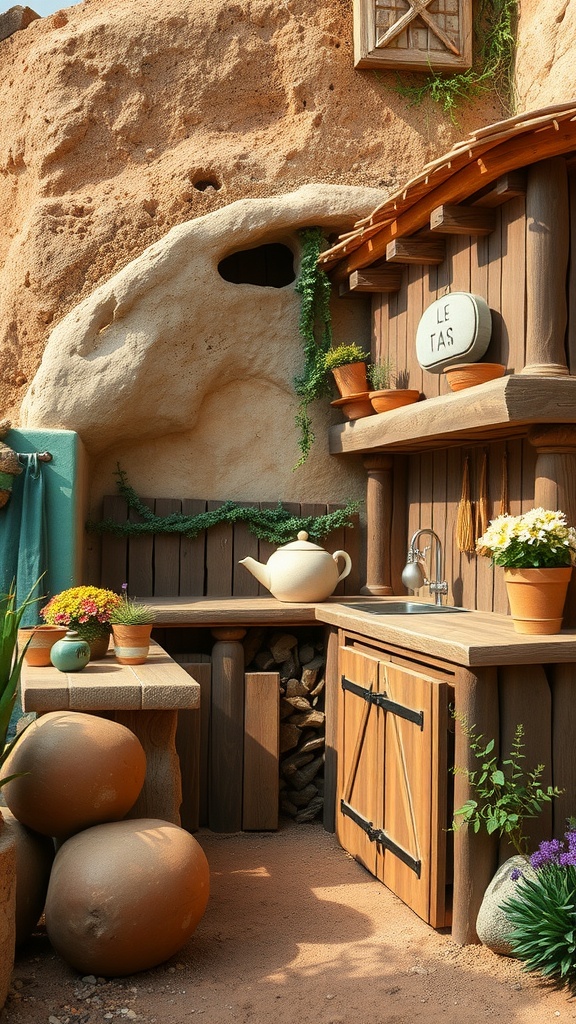
Creating a mud kitchen is a fun way to blend play with nature. The image shows a charming setup that highlights the use of natural materials.
The wooden surfaces and earthy colors create a warm and inviting space. Children can engage with the textures, from the sturdy wood to the smooth stones. This setup encourages exploration, allowing kids to feel connected to their surroundings.
Plants and flowers add a splash of color and bring life to the kitchen. They can spark curiosity about nature, making it easy for kids to learn while they play.
The integration of elements like rocks and pots makes this kitchen feel earthy and grounded. It inspires imaginative play, letting children create their own recipes and stories. This design emphasizes the importance of natural elements in play spaces.
Incorporating Sensory Play Elements
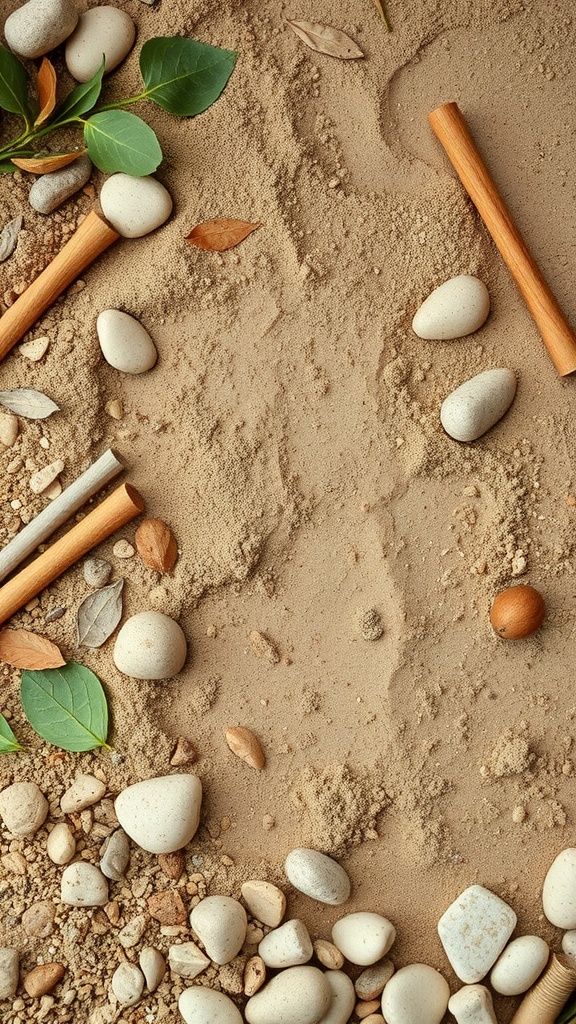
Creating a mud kitchen for kids opens up a world of sensory play. The image showcases a mix of textures, colors, and natural elements that can spark curiosity and creativity. Here, we see a sandy surface scattered with smooth stones, wooden sticks, and leaves. These elements invite children to touch, explore, and experiment.
Sensory play is vital for children’s development. It helps them learn through their senses. In this setup, kids can feel the grit of the sand, the smoothness of the stones, and the softness of the leaves. These contrasts can lead to imaginative play as they create their own recipes or concoctions.
Incorporating items like sticks encourages kids to use their imagination. They can pretend to mix ingredients or serve up a feast. The natural elements add an organic touch, fostering a connection with nature as they play outdoors. This hands-on experience is both fun and educational.
Edible Garden Integration with Mud Kitchens
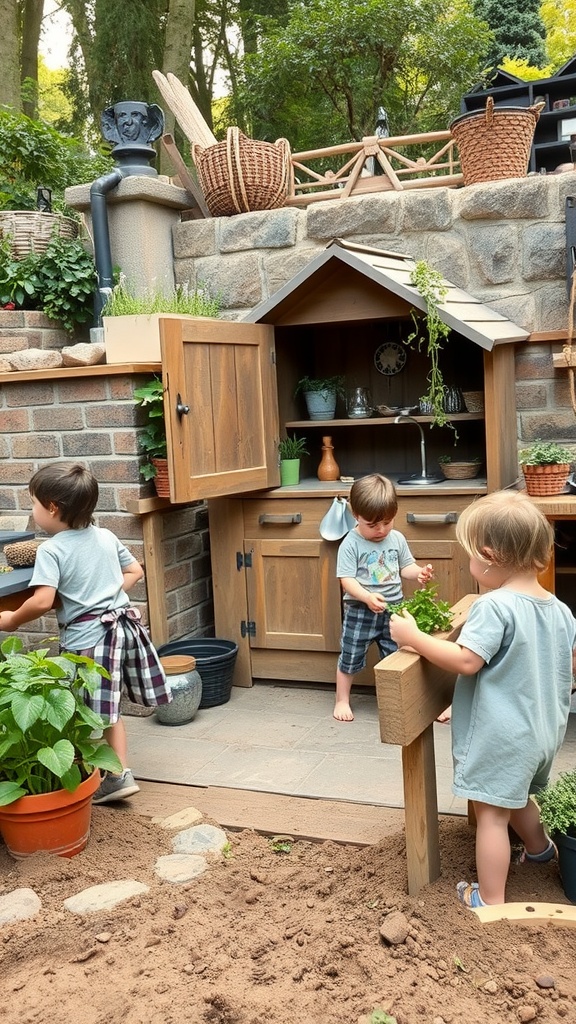
Mud kitchens are not just about mess and fun; they can also connect kids with nature through gardening. The image shows children engaging with their mud kitchen while surrounded by plants and gardening tools. They are exploring edible plants, which makes the experience even more enriching.
Incorporating an edible garden into a mud kitchen allows kids to learn about where food comes from. Each plant can be a teaching moment, from herbs like basil to vegetables like tomatoes. Children can pick fresh ingredients to use in their imaginary cooking, sparking creativity and encouraging healthy eating.
Setting up a space that blends both gardening and cooking is simple. Start with a few pots of herbs or vegetables that are easy to grow. Children can help with planting, watering, and eventually harvesting their crops. This hands-on approach teaches responsibility and the basics of gardening.
With a mud kitchen and an integrated edible garden, playtime turns into a delightful blend of learning, creativity, and healthy habits. Kids not only enjoy playing in the dirt but also develop a sense of pride in what they grow. It’s a fantastic way to foster a love for nature in young ones!
Creative Play Accessories for Mud Kitchens
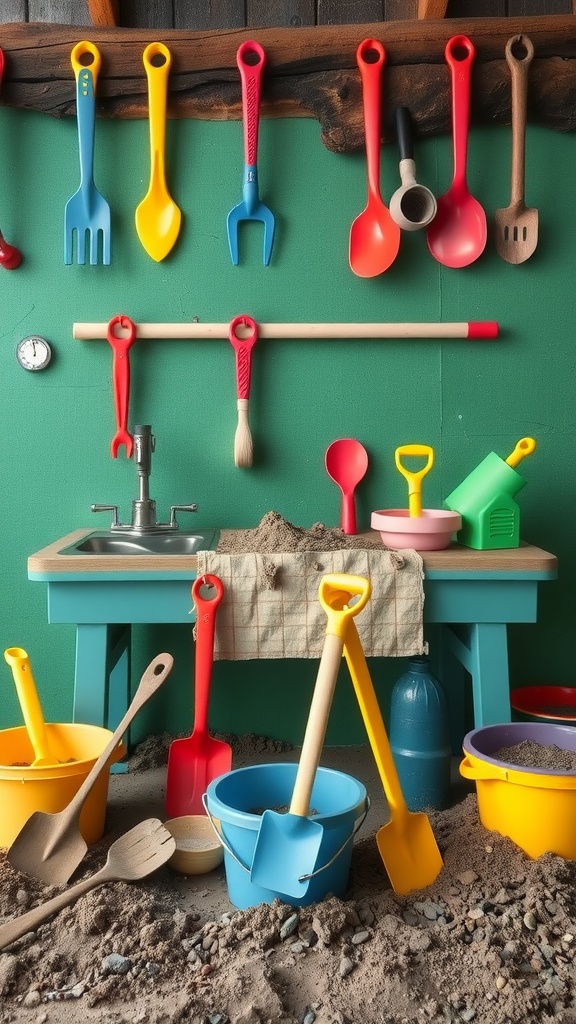
A mud kitchen can be a delightful space for kids to explore their creativity. The image shows a colorful array of tools and accessories that make this space fun and engaging. Brightly colored shovels, buckets, and spoons hang neatly on the wall, ready to be used for imaginative play.
The setup includes a small sink, perfect for rinsing off hands or mixing mud pies. The different sizes of buckets invite kids to gather materials from around the yard or garden. Each tool, whether a big red shovel or a tiny yellow scoop, encourages different types of play and exploration.
Having a variety of accessories is key to keeping playtime interesting. Kids can experiment with textures, mix colors, and even create their own ‘recipes’ using natural elements. This type of creative play helps develop fine motor skills and fosters a love for nature.
Overall, a well-equipped mud kitchen is not just a play area; it’s a space for learning and discovery. With all these vibrant tools at their fingertips, kids can engage in endless hours of imaginative play.
Seasonal Themes for Mud Kitchen Play

Creating a mud kitchen for kids allows for seasonal themes that spark creativity and joy. Picture this lovely autumn setup, where vibrant leaves and pumpkins set the stage for outdoor play.
The warm colors of fall inspire kids to collect leaves, acorns, and other natural items for their mud kitchen. They can mix mud with leaves to create ‘soups’ or ‘cakes’ that reflect the rich hues of the season. This encourages them to explore nature while developing their imagination.
Don’t forget to incorporate seasonal decorations! Kids can use mini pumpkins and colorful leaves to garnish their creations. These elements add fun and excitement, making playtime even more engaging.
As the seasons change, so can the themes. Winter might bring snow-themed mud play, while spring could introduce flower petals and fresh herbs. Each season offers unique opportunities for learning and creativity in the mud kitchen.
Safety Features in Mud Kitchen Designs
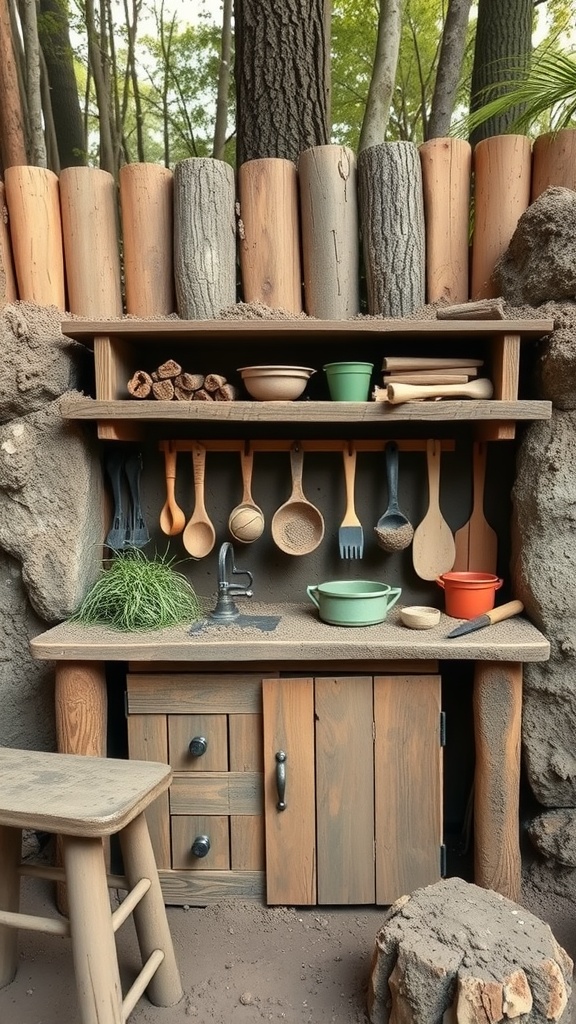
When it comes to mud kitchens for kids, safety features are key. The image shows a charming mud kitchen made from natural materials, giving it a rustic feel. It’s essential that these kitchens not only inspire creativity but also keep children safe during play.
The sturdy construction seen here is vital. The use of wood and other robust materials ensures that the kitchen can withstand rough handling. Rounded edges on the furniture also help to prevent injuries, making it a safer environment for kids to play.
Additionally, having a designated spot for tools and materials, as shown in the image, keeps everything organized. This reduces the risk of tripping over items left scattered on the ground. Proper storage encourages kids to clean up after themselves, a great habit to start early.
Another important aspect is the non-toxic finishes on surfaces. This mud kitchen appears to be treated with child-safe products that won’t harm little hands. Parents can rest easy knowing that their kids are playing in a safe environment.
Finally, positioning the kitchen in a supervised area allows adults to keep an eye on the kids while they create their mud pies and concoctions. Combining fun and safety makes for the best play experience!
Incorporating Water Features in Mud Kitchens
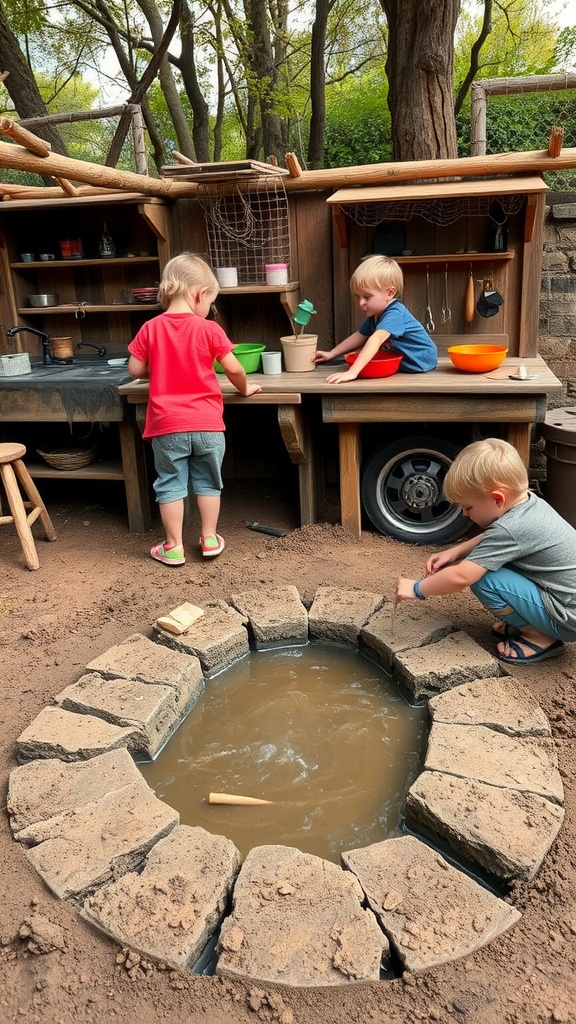
Water features can really spice up a mud kitchen for kids. Imagine a small pond, just like the one in the picture, where kids can splash and play. This setup brings a whole new level of excitement to outdoor play.
The children in this image are fully engaged, making their own creations while enjoying the natural elements around them. The round stone border serves as a safe area for them to play without the risk of stepping into muddy water. It also invites kids to explore different textures and materials.
With a water feature, kids can mix mud, create potions, or even experiment with floating objects. This type of play fosters creativity and encourages teamwork as they collaborate on their mud kitchen creations.
Adding water to a mud kitchen is not just fun; it can also be educational. Kids can learn about measurements and basic science through their play. They might discover how water flows or how different materials interact when mixed together. Overall, water features enhance the mud kitchen experience, making it both entertaining and enriching.
Designing a Mud Kitchen for Small Spaces
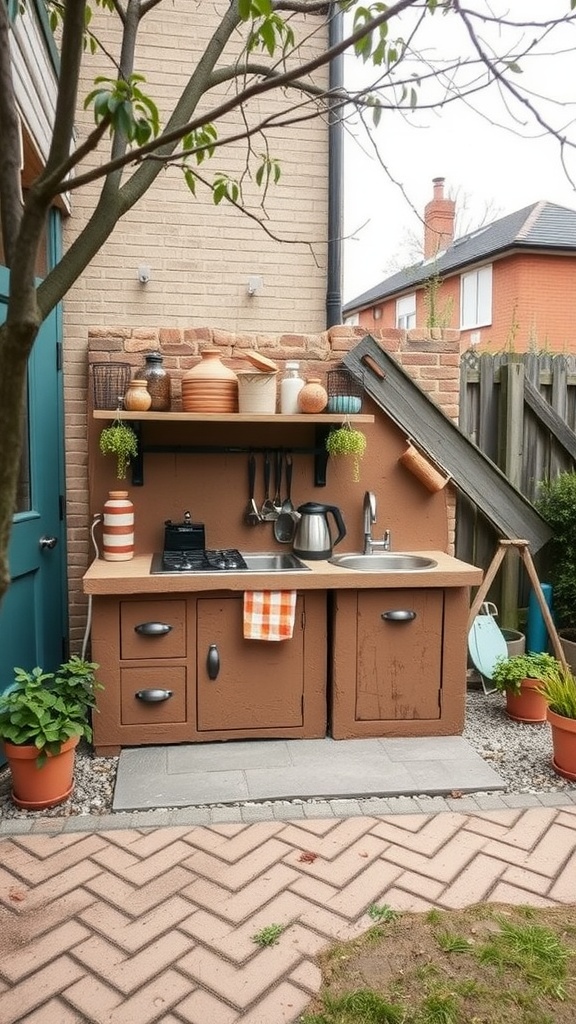
Creating a mud kitchen in a small area is easier than you might think. The image shows a charming setup that fits perfectly in a compact outdoor space. With thoughtful placement, even a tiny backyard can accommodate a fun cooking spot for kids.
The kitchen features a sturdy countertop, sink, and even a few cooking essentials neatly arranged on a shelf above. The use of earthy colors and natural materials blends well with the outdoors, making it inviting for little chefs. A few potted plants add a touch of greenery, enhancing the overall look.
Storage is key in smaller spaces. This design includes cabinets that keep utensils hidden while still being accessible. Kids can easily explore their creativity without clutter taking over the space. The surrounding pathway is practical, ensuring easy movement around the area.
Don’t forget to add a splash of creativity! Think about using recycled materials or simple wooden pallets to create a unique look. With a bit of imagination, you can transform even a small corner into a delightful mud kitchen.
Encouraging Imaginative Play in Mud Kitchens
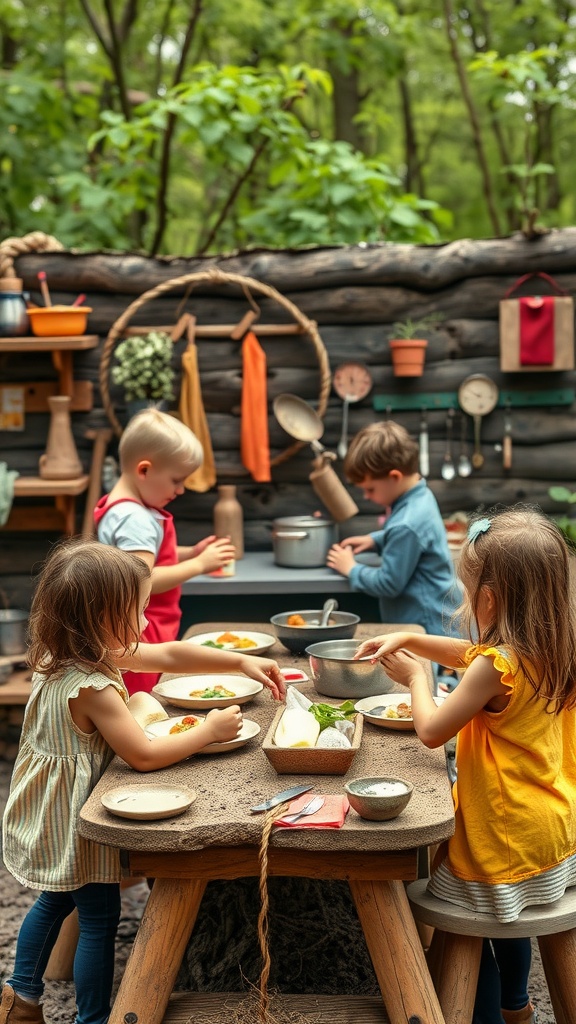
Mud kitchens are more than just a fun outdoor play area. They spark creativity and imagination in kids. In the image, you see children engaged in play, surrounded by nature and a rustic kitchen setup. This environment encourages them to explore and enjoy hands-on activities.
As they mix materials like mud, leaves, and water, they create their own recipes and stories. Every pot and pan can turn into a new dish, fueling their imagination. This type of play allows kids to experiment and learn through their senses.
Playing in a mud kitchen also promotes teamwork. In the image, children are working together, sharing tools and ingredients. This not only builds social skills but also helps them develop language skills as they communicate during their play. Encouraging this kind of imaginative play is essential for their growth and development.
Overall, mud kitchens provide a perfect blend of fun and learning. They become spaces where kids can let their imaginations run wild while enjoying the outdoors and connecting with nature.
DIY Mud Kitchen Projects for Parents
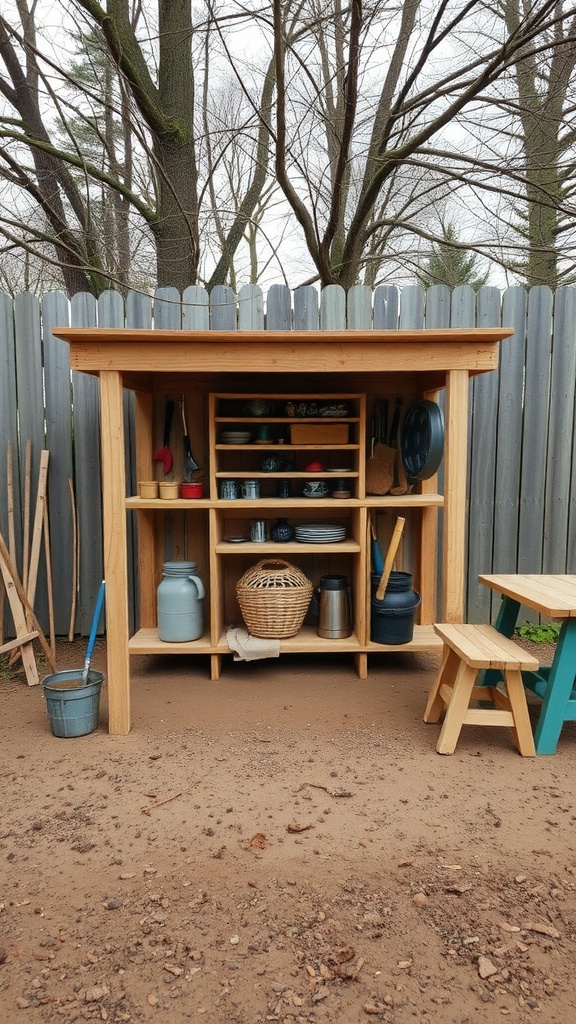
Creating a mud kitchen for kids can be a fun and rewarding project. The image shows a charming wooden mud kitchen, complete with shelves and a small table. This setup invites little ones to explore their creativity while playing outside.
The mud kitchen features various pots, utensils, and containers, encouraging kids to mix, pour, and pretend cook. It’s a fantastic way for children to engage in sensory play. The natural materials used in the kitchen blend seamlessly with the outdoor environment, making it an appealing play area.
Parents can easily build a similar setup at home with some wood and basic tools. All it takes is a bit of imagination and a few fun accessories. Kids will love having their own space to create muddy masterpieces!
Environmental Benefits of Mud Kitchens
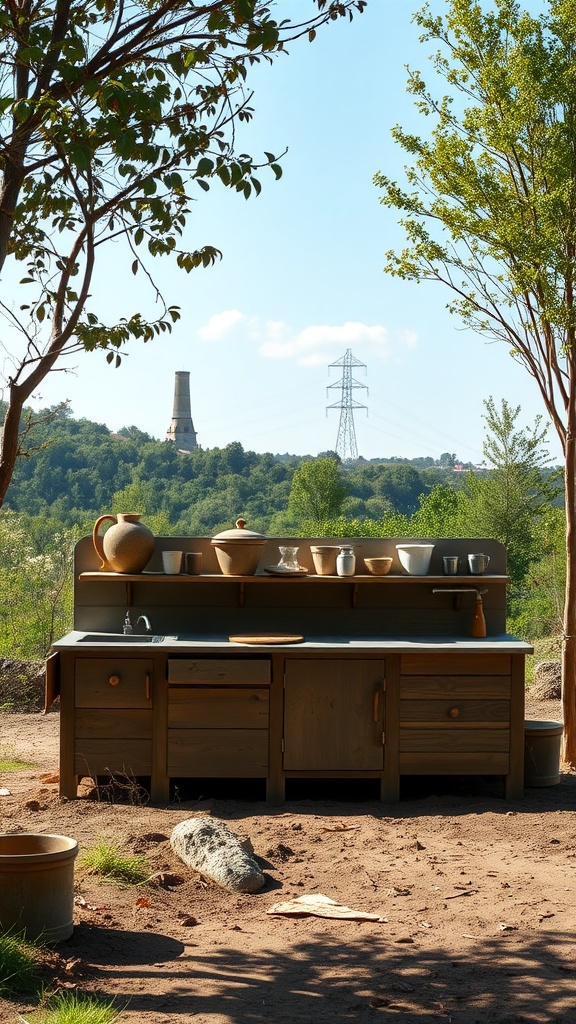
Mud kitchens offer more than just a fun play area for kids. They also play a role in promoting environmental awareness. By encouraging outdoor play, these kitchens connect children with nature. This engagement fosters a sense of responsibility towards the environment.
When kids interact with soil and plants, they learn about ecosystems. They see how everything is connected. This hands-on experience helps them understand the importance of keeping nature clean and healthy.
Mud kitchens can also benefit local wildlife. By creating a space with natural materials, you invite various creatures to visit. Birds, insects, and other animals can thrive in these habitats, promoting biodiversity.
Another advantage is the use of sustainable materials in building mud kitchens. Many are made from wood and stone, reducing plastic waste. This choice encourages mindfulness about resource use and helps instill eco-friendly habits in children.
Collaborative Mud Kitchen Projects
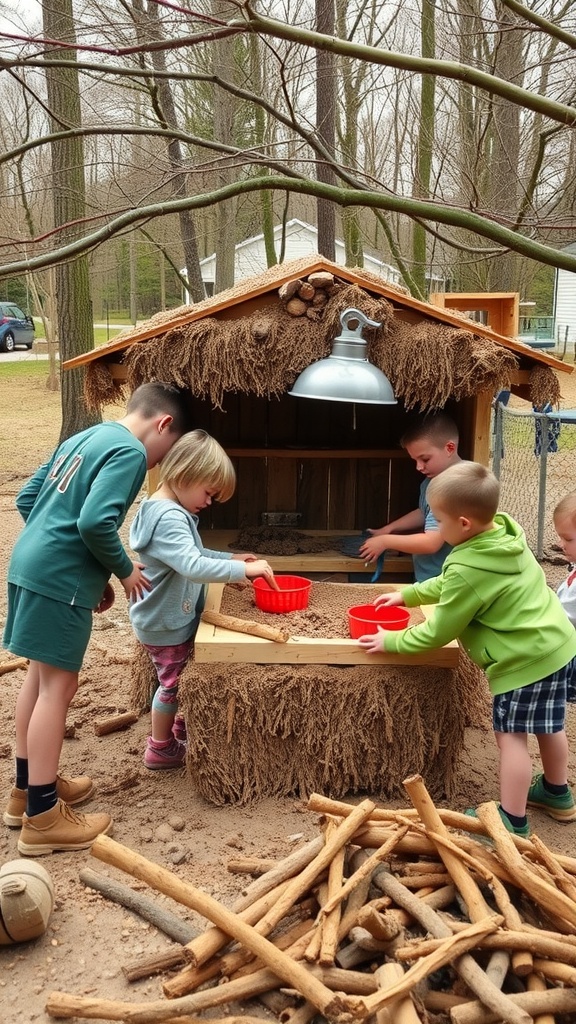
Kids love getting their hands dirty, and a mud kitchen is the perfect spot for them to dive into imaginative play. In this image, a group of children is gathered around a charming mud kitchen. They are busy using red buckets to scoop up some of the sandy texture that surrounds them. Their focus shows how engaging this setup can be.
The mud kitchen is not just a place for mud. It’s where creativity sparks! Children can mix dirt, water, and other natural items to create their own ‘recipes.’ Each child can contribute to the project, fostering teamwork and collaboration. They learn to share tools and ideas, making the experience even more enriching.
Building a mud kitchen can be an exciting group effort. Parents and caregivers can get involved too, helping children gather materials like sticks, stones, and leaves to enhance their play. This encourages not just teamwork but also connection with nature.
The Role of Mud Kitchens in Early Childhood Development

Mud kitchens provide a fantastic space for kids to engage in imaginative play. In this image, three children gather around a rustic wooden kitchen setup, filled with bowls and various kitchen tools. They seem focused and excited, exploring textures and experimenting with their surroundings.
Playing in a mud kitchen encourages creativity. Children can mix dirt, water, and natural materials to create whatever their imagination conjures. This process helps develop fine motor skills as they scoop, pour, and mold. The act of getting their hands dirty adds an element of fun that keeps them engaged.
Moreover, mud kitchens foster social skills. As kids play together, they communicate, share ideas, and collaborate on their creations. This interaction is crucial for building friendships and learning to work as a team. The laughter and chatter in this setting create a lively atmosphere that enhances their learning experience.
Outdoor play, like that seen in the image, also supports physical development. Running back and forth to collect materials or participating in group activities promotes movement and coordination. Mud kitchens bridge the gap between play and learning, making them a valuable addition to early childhood environments.
Cultural Inspirations for Mud Kitchen Designs
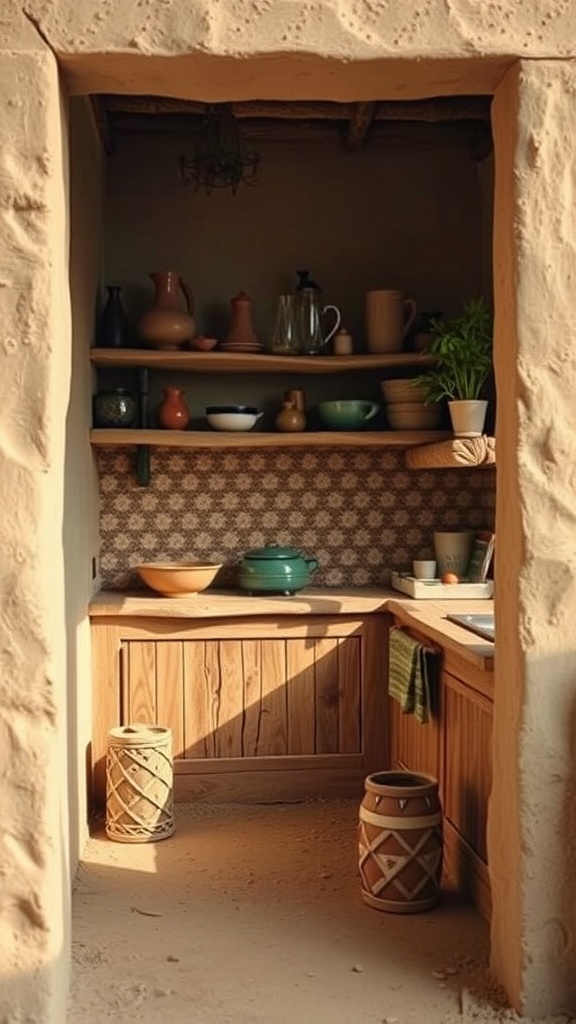
The image shows a cozy, rustic mud kitchen that gives off a warm, inviting feel. The soft colors and natural materials reflect a connection to the earth, making it a perfect spot for children to explore their creativity.
Many cultures around the world embrace the idea of outdoor cooking and play. This design takes cues from traditional homes where natural elements are key. The wooden shelves and earthy tones speak to a simpler way of life, where children can enjoy hands-on activities.
In some cultures, playing with mud and creating food from natural materials is a rite of passage. It helps kids learn about their environment and encourages imaginative play. Inspired by these traditions, this mud kitchen invites kids to experiment and create, using their surroundings as a backdrop for fun.
From the pots and bowls to the earthy textures, each element in the kitchen design encourages children to engage with nature. It’s not just about cooking; it’s about learning and discovering through play. This cultural inspiration makes mud kitchens a wonderful addition to any backyard.
Adapting Mud Kitchens for All Weather Conditions
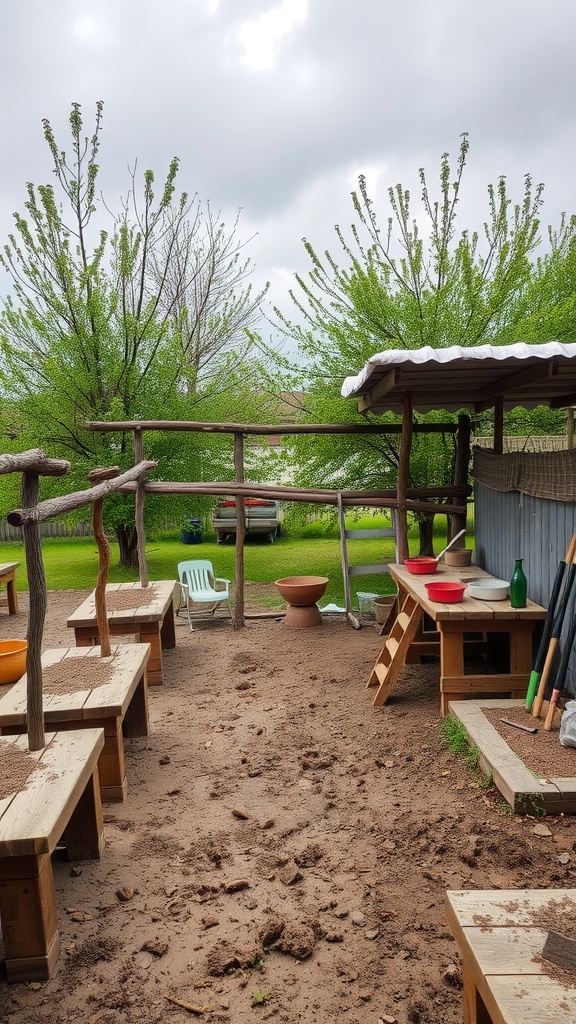
Creating a mud kitchen for kids is a fantastic way to encourage outdoor play. The image shows a well-equipped space with wooden tables, benches, and various containers ready for mixing and crafting. The natural setting, surrounded by trees and a hint of cloud cover, is perfect for imaginative play.
When designing this kind of kitchen, it’s important to think about weather. Rain can turn mud into a slippery mess, while sun can dry it out. Adding a roof, like the one in the image, helps keep the mud usable even when it drizzles. You can also provide shaded areas for sunny days, ensuring kids can play comfortably.
Storage solutions are key too. Consider using waterproof bins for supplies, so they stay dry regardless of the weather. Kids can have fun regardless of whether it’s sunny or rainy with the right setup!
Let’s not forget the importance of cleanup. Having a designated area for rinsing tools and washing hands makes it easy to tidy up after play. Encourage kids to be responsible and help with cleaning. This teaches them valuable life skills while they have fun!





